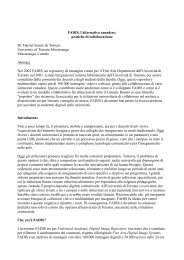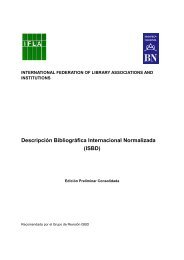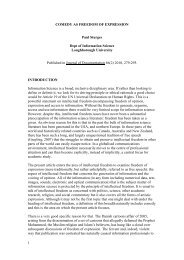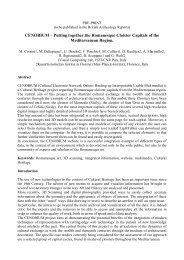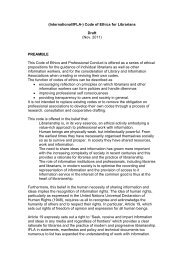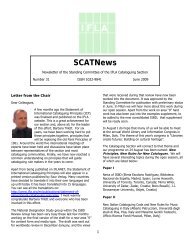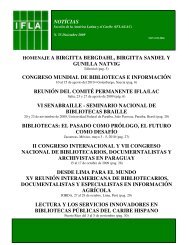ISBD(NBM) - IFLA
ISBD(NBM) - IFLA
ISBD(NBM) - IFLA
You also want an ePaper? Increase the reach of your titles
YUMPU automatically turns print PDFs into web optimized ePapers that Google loves.
– when quotations are provided in area 7;<br />
– when key-title is given in area 8.<br />
The description of items appearing in scripts other than that used by the national bibliographic agency<br />
may, if necessary, be transliterated or transcribed without brackets into the script used by the agency.<br />
0.7 Abridgements and abbreviations<br />
0.7.1 In exceptional cases the abridgement of certain elements in the description is permitted,<br />
provided the omission takes place at the end or in the middle of the element (e.g. a lengthy title proper,<br />
see 1.1.4.1). In such cases, the omission is indicated by marks of omission.<br />
0.7.2 In the case of the abridgement of a single statement of responsibility consisting of the<br />
names of several persons or corporate bodies (see 1.5.4.3), the omission is indicated by marks of<br />
omission and the insertion of the prescribed abbreviation "et al." ( = et alii, and others) enclosed in square<br />
brackets (or for non-roman script records, its equivalent in another script).<br />
0.7.3 Other abbreviations are prescribed in specific stipulations (e.g. 4.1.15, 5.3.1.)<br />
0.7.4 In various stipulations in the <strong>ISBD</strong>s, provision is made for the use of "standard<br />
abbreviations" (e.g. in the edition statement, see 2.1.2) without specifying the forms of the abbreviations to<br />
be followed. These abbreviations are not prescribed and it is recommended that ISO 832-1975,<br />
Documentation – Bibliographical references – Abbreviations of typical words, or similar national standards,<br />
be used.<br />
The abbreviations used throughout the <strong>ISBD</strong>s in the examples, other than those prescribed above in 0.7.2<br />
and 0.7.3, are illustrative and not prescriptive (see also Appendix D).<br />
0.7.5 Except for specifically prescribed or permitted abridgements and abbreviations, the<br />
transcription of data in areas 1, 2 and 6 does not show abbreviations unless they appear in the source.<br />
0.8 Capitalization<br />
In general, the first letter of the first word of each area should be a capital; the first letter of the first word of<br />
some elements (e.g. general material designation, parallel title, alternative title, section title) should also be<br />
a capital. Other capitalization should follow the appropriate usage for the language(s) and/or script(s) used<br />
in the description (see 0.6). When more than one language and/or script appears in the description, each<br />
should be capitalized in accordance with the usage of that language and/or script even when this produces<br />
an inconsistent pattern of capitalization for the description as a whole.<br />
0.9 Examples<br />
The examples given throughout the <strong>ISBD</strong>s are illustrative and not prescriptive except when the stipulations<br />
specify that the form found in the example(s) is to be followed. Most examples are based on the<br />
description of existing items but some fictitious examples have been included.<br />
In the English text of the <strong>ISBD</strong>s the terms used and the words or short phrases added to the examples in<br />
areas 5, 7 and 8 are in English. It is anticipated that in translations of the <strong>ISBD</strong>s, such terms and words<br />
and phrases will be given in the language of the translation.<br />
16



